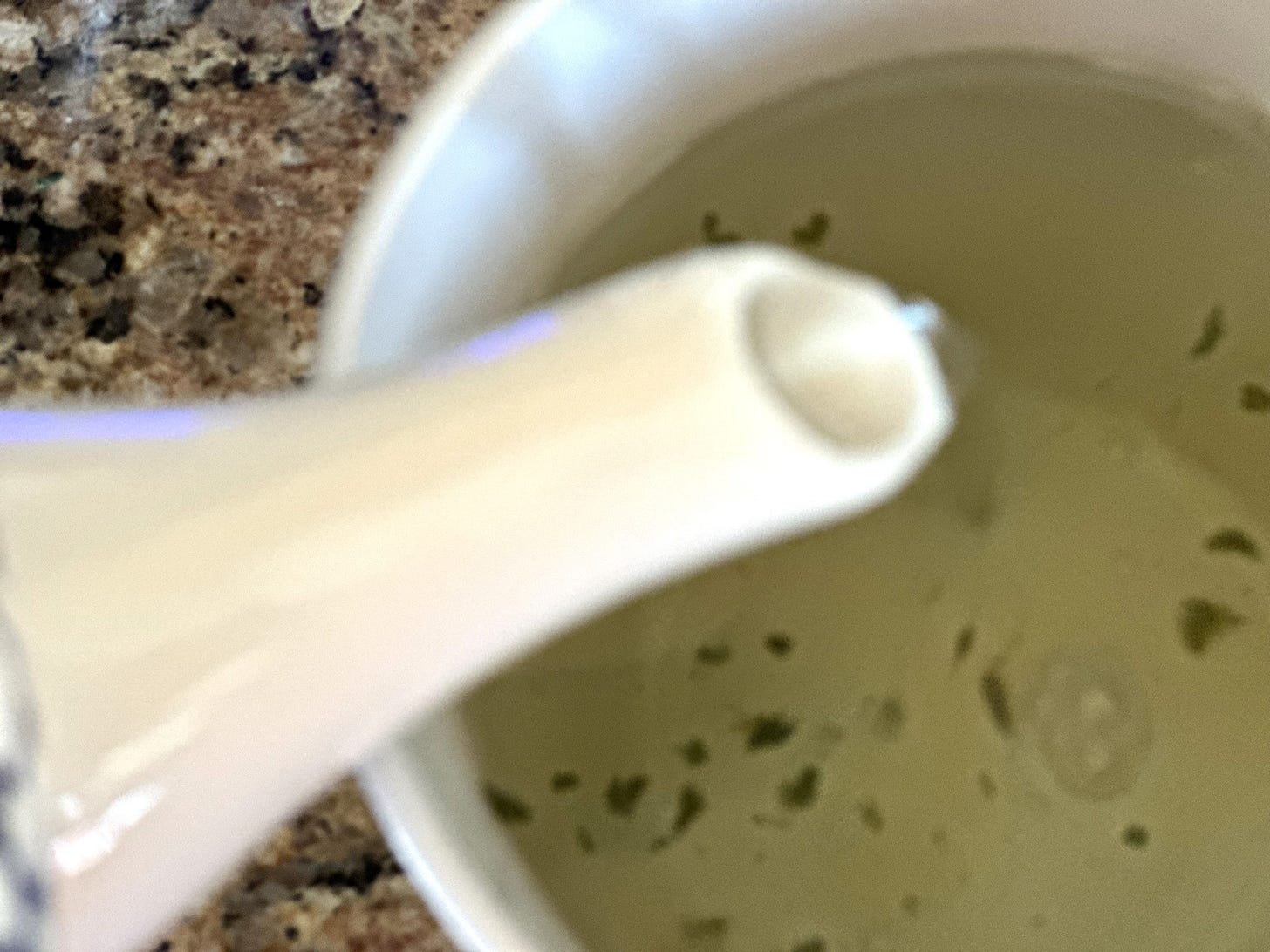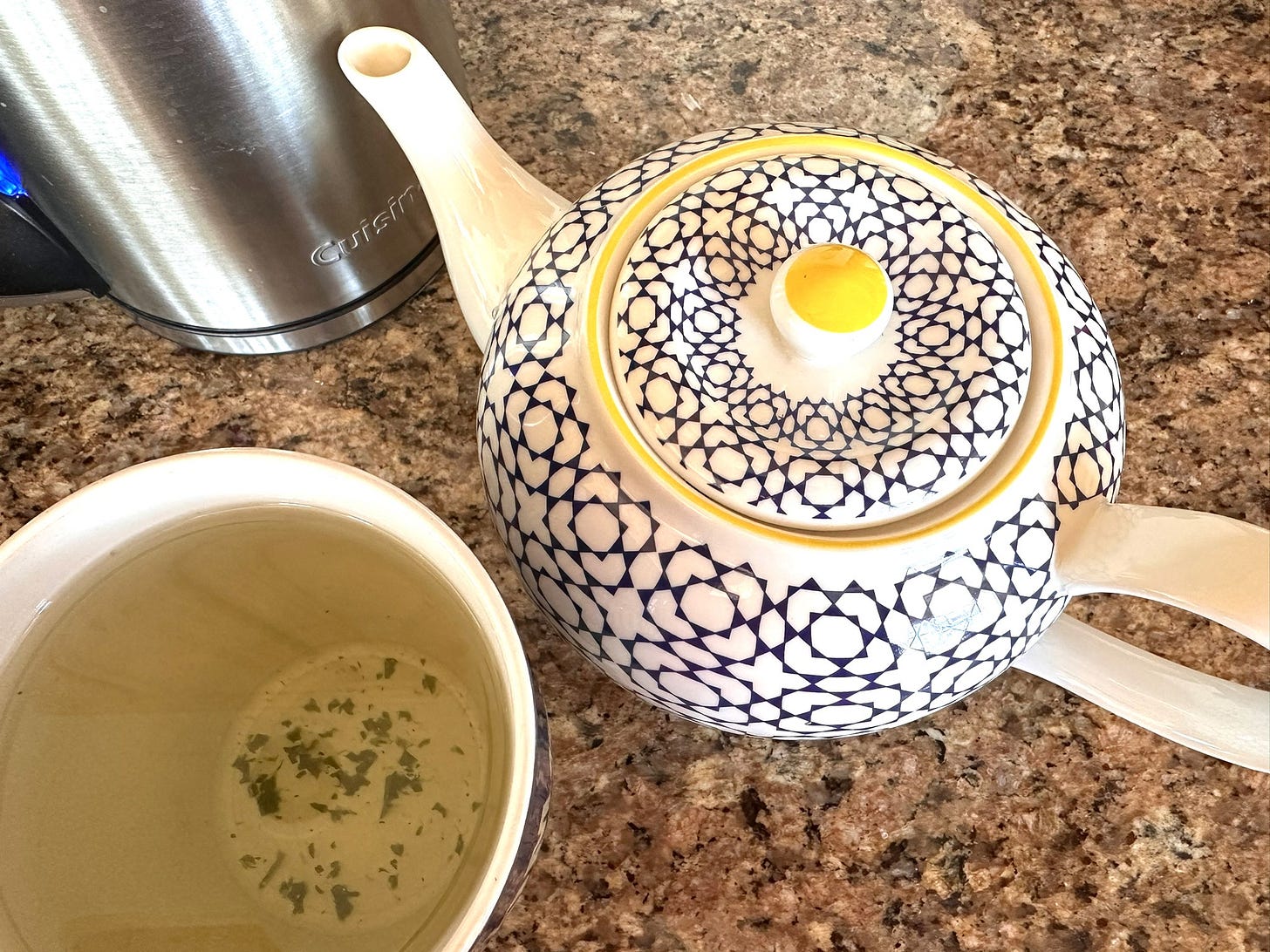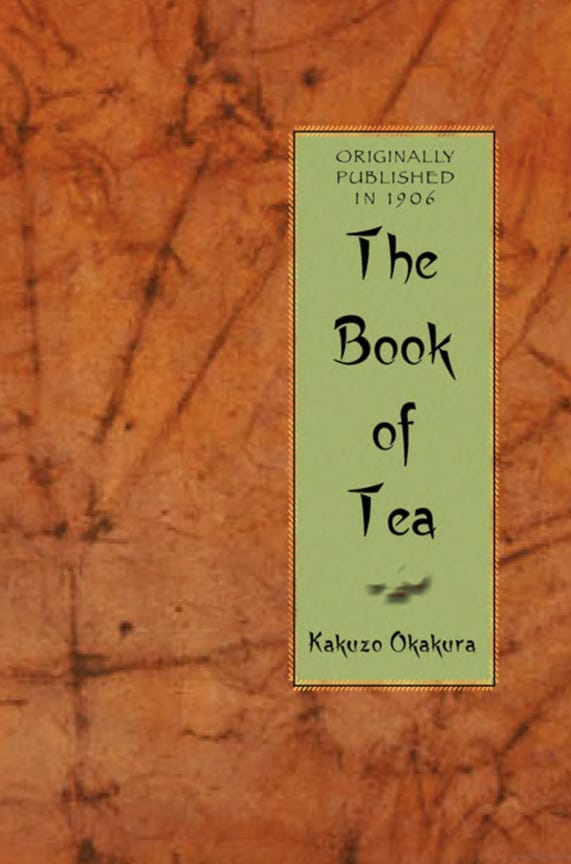🍵 Finding Well-being, Nature and Tranquility in Your Cup of Green Tea
Recipe: Steeped Sench Green Tea
Hey 7410 Style Family,
You might be surprised to hear that tea beats out coffee as the second most consumed drink in the world. Water ranks first, of course. We humans have been drinking tea, the scientific name is Camellia sinensis, for millennia.

The earliest reports of tea come from China. According to myth, the Chinese emperor Shennong (on Shen Nong), born in the 28th century BCE, was resting under a Camellia sinensis tree while his servant boiled drinking water nearby. The wind blew some leaves from the tree into the water, and the emperor drank the leaf water. He enjoyed the aroma and complex flavors, and found the new drink to be mildly stimulating. Revered as the father of Chinese herbal medicine, he quickly may have recognized the healing properties of the new drink.
People continued to prepare tea by boiling fresh leaves in water for its healing properties for thousands of years until around the 3rd century CE when it became a daily drink. Tea culture is also an important tradition in Japan. The art of tea emphasizes mindfulness and an appreciation of nature. So it appears that a few cups of green tea are an optimal place to find well-being, an appreciation of the imperfect beauty of nature, and a mindfulness practice.
Well-being
So it’s no surprise that as the Chinese began drinking tea for medicine so long ago, we modern-day humans also recognize the healing properties of green tea and how it can enhance our well-being. A substantial body of research has explored the health benefits of green tea. These studies have investigated potential healing effects on neurodegenerative diseases, cancer, heart disease, diabetes, bacteria, and even oral health.
Unlike black tea, green tea is not fermented, so it retains most of its original phytochemicals. Accordingly, green tea has the highest amount of polyphenols, that is chemical compounds rich in antioxidant and anti-inflammatory properties. More than 500 chemical components have been isolated from tea. These compounds include polyphenols, caffeine, theanine, and tea polysaccharides.
Studies have shown that the phytochemicals in green tea can help protect us from neurodegenerative diseases, such as Alzheimer’s and Parkinson’s diseases, and significantly improve learning and memory. Green tea contains catechins, theanine, and caffeine. These increase antioxidant activity. Antioxidants neutralize free radicals, molecules that can damage the body’s cells, and reduce the risk of inflammation, heart disease, cancer and cognitive decline. This antioxidant activity can also be effective in preventing heart disease, and improving insulin resistance and glucose metabolism, while also reducing blood sugar and triglyceride levels.
Green tea has anti-cancer properties. It has been shown to inhibit migration and invasion of tumor cells, and induce a form of programmed cell death that keeps cell growth and death in balance. This balance prevents tumor growth and spreading of the cancer cells throughout the body. Green tea also has antibacterial properties. It has been shown to inhibit bacteria including helicobacter pylori, a type of bacteria that infects the stomach. This bacteria can cause peptic ulcers, sores which can lead to stomach cancer.
Drinking green tea without sweeteners can help prevent gum disease by reducing inflammation in the mouth and stopping harmful bacteria that harm the gums. Green tea can also help prevent cavities through its antibacterial activity. Its polyphenols are effective against most cavity-causing bacteria. Green tea can even help with bad breath.
Research is continuing on the healing properties of green tea, though it’s mostly on isolating and studying the individual compounds. There are also some concerns about drinking too much green tea. Drinking a large amount of green tea can stain your teeth. If you are concerned about discoloration, rinse out your mouth with water after drinking your tea or use a straw. Another concern is that some medications can interact with green tea. There are websites to check for drug interactions.
Finally, some people have a genetic variation that causes them to feel the effect of caffeine more powerfully and for a longer period of time. Keep in mind that actual caffeine content can vary based on processing and brewing time. For perspective, an 8-ounce cup of brewed coffee has 96 milligrams of caffeine while a 1-ounce espresso has 64 milligrams. An 8-ounce cup of brewed black tea has 47 milligrams of caffeine while the same size cup of brewed green tea has 28 milligrams. That’s nothing compared to some 2-ounce energy shots containing 215 milligrams of caffeine.

The Imperfect Beauty of Nature
The Japanese tea ceremony, known as Sadō or Chanoyu, is a highly formalized ritual. It is rooted in the principles of Zen Buddhism and founded on simplicity, beauty in the daily routine of life and an appreciation of the natural world. For the Japanese, the tea ceremony became more than just preparing tea and drinking it. It is a practice that embodies art, philosophy and spirituality.
The tea ceremony is designed to form a harmonious connection with nature. A garden path leads through the garden to the traditional tea house. The winding path sets the mood for tranquility and wonder of the natural world in the green leaves fluttering in the breeze, the branches gently swaying, and a shy flower bud peeking from behind tender, young leaves. Being surrounded by nature creates a serene atmosphere.
Tea utensils are made from natural materials. The emphasis on connection to the earth enhances tranquility. Imperfection is celebrated. The chawan is a type of tea bowl typically made of ceramic or pottery. They often have deliberately imperfect shapes with visible tooling marks reminding us to find the beauty of nature in imperfection.
Cherish Each Moment
It’s too easy for our minds to get caught up in daily activities and daily distractions. As we try to multitask and get all our work done, our minds get caught up in thoughts and stories that have nothing to do with what’s happening in the moment. In the tea ceremony, making and drinking tea become meditative practices with the intention that each moment should be cherished with full attention and mindfulness. Each moment happens only once, never again to be experienced. Fuyu writes:
More than just a ritual, the tea ceremony is an art form that involves deliberate actions, mindful movements, and unwavering focus on the present moment.
Our minds are used to thinking, analyzing, ruminating. Our minds are constantly seeking something to think about, often stuck on past wrongs or future worries. Engaging in mindfulness practices can retrain our brains to focus on the present moment. We don’t have to travel to Japan to attend a tea ceremony to find tranquility. Rather we can borrow from their practices to cultivate our own ritual of drinking green tea.

It might start by appreciating the green tea leaves as you scoop up a spoonful and place them into your tea pot or place a tea bag into your cup. Watch the steam rise as the water starts to heat up. Inhale the aroma of the tea as it steeps. Pour the tea into your cup and notice the color of the tea and any bits of tea leaves that escaped your tea pot. Take a small sip and notice the flavors and sensations. Take deep breaths between sips. Reflect on the journey of the tea leaves from the farm to the store to you and express gratitude for all the people and effort that went into creating this moment. After finishing your tea, end by reflecting on the experience and how it made you feel.
Remember, mindfulness is a practice. It’s okay if your mind wanders. Gently guide your attention back to the present moment and the experience of drinking tea. You may not experience tranquility every time. However, know that you are planting a seed of tranquility that will eventually blossom.
Wishing you the best,
Rhonda
P.S. You can catch up on past newsletters at the 7410 Expanded website.
🎦7410 Style Video Spotlight
Have you ever felt depression, anxiety, guilt, denial, even impacts to brain function and mood disorders because you eat meat and recognize how much pain, suffering and violence that is caused in turning an animal into a package of meat? This conflict is known as the meat paradox. In this video, we explore the meat paradox, how to break it, an inspirational example and recipe that can be your first step. Links to sources and products in this video are below.
👩🍳In the Kitchen: Steeped Sencha Green Tea
There are many different types of green tea. The best steeping time for your green tea depends on the type you’re using, the quality of the tea leaves and your preference. Most Japanese green teas require 30 seconds for a lighter flavor to 2 minutes for a stronger flavor at the right temperature. Using boiling water can damage the tea leaves. Over 3-4 minutes can make the tea taste bitter. I usually start with the instructions on the package and adjust from there. One of the most popular Japanese green teas is Sencha. It is characterized by a balance of sweet, astringent and bitter flavors with a pleasant aroma. If you prefer the ease of bagged tea, there are many brands to choose from along with flavored green tea, like mint, fruit, or lemongrass. The type of green tea used in Japanese tea ceremonies is powdered green tea, or matcha. I’ll tackle matcha in a future newsletter.
Ingredients
• 1 teaspoon of loose Sencha green tea leaves per person (More for a stronger flavor) • Water
Instructions
• Put tea leaves in the teapot. • Heat water to 175°F (80°C) (If you don’t have an electric teapot that can heat to this temperature or no thermometer, heat the water to boiling then let cool for 2 minutes). • Pour hot water in the teapot and wait 60 to 90 seconds. Rotate the pot slowly to allow the tea leaves to open up. Then, pour the tea until the last drop. • Add water to the pot again for one or two more infusions. Wait 10 seconds before pouring into your cup. The flavors will change with each infusion.
📖Book Boost
Okakura Kakuzo was a Japanese philosopher, educator and art historian. In the Book of Tea, he describes the Japanese tea philosophy:
. . . a cult founded on the adoration of the beautiful among the sordid facts of everyday existence. It inculcates purity and harmony, the mystery of mutual charity, the romanticism of the social order. It is essentially a worship of the Imperfect, as it is a tender attempt to accomplish something possible in this impossible thing we know as life.
You can read the entire book online on Google Books:
📱Screen Time
Can Green Tea Help Prevent Cancer?
Dr. Michael Greger talks about how within 40 minutes of green tea consumption we get a boost in antioxidant power of our bloodstream and within 60 an upregulation of DNA repair.
🎒Research Study
Foods Rich in Polyphenols — and Why They’re Important
This article by the Cleveland Clinic explains polyphenols and which foods are rich in them. Devon Peart, RD, MHSc, a registered dietician explains their importance:
Polyphenols are simply a category of phytonutrients, which are chemical compounds in plants that provide specific health benefits. Along with other nutrients in plants, like fiber, vitamins and minerals, polyphenols can help protect your body from the root causes of many chronic illnesses.
Green Tea (Camellia sinensis): A Review of Its Phytochemistry, Pharmacology, and Toxicology
In this review of research results of green tea, Tiantian Zhao and colleagues describe how green tea can be used to assist in the treatment of diabetes, Alzheimer’s disease, oral cancer and dermatitis. They also discuss how green tea has shown promising prospects in health care and disease prevention.
In this review, Mohammad Zamani and colleagues summarize the effects of green tea on cardiovascular risk factors, such as fasting blood sugar and cholesterol.
The Principles of Tea Ceremony by Sen No Rikyu
In this blog, Fuyu describes the Zen Buddhist roots of Sen Rikyu’s four principles of the Japanese tea ceremony and how to incorporate them into your daily life. The four principles are Harmony, Respect, Purity and Tranquility.
The Evolution of the Tea Ceremony
Paul Varley discusses the history of Japan’s tea ceremony, a unique Japanese art.





I love these newsletters, thank you for putting so much effort into them. <3